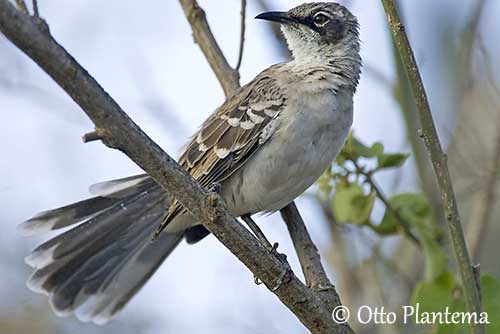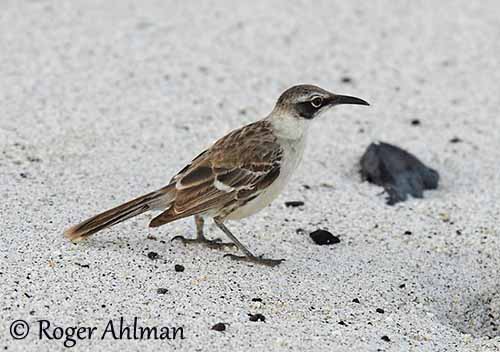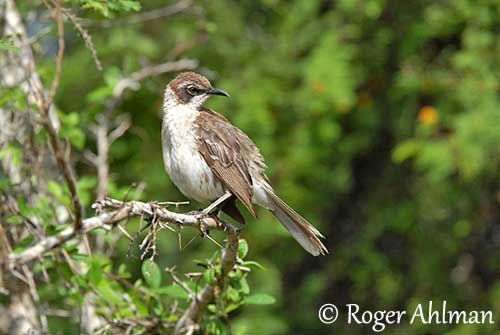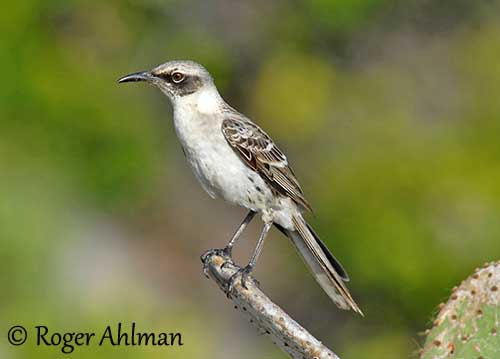
Fr: Moqueur des Galápagos
All: Galapagosspottdrossel
Esp: Sinsonte de Galápagos
Esp Ecuador: Cucube
Ita: Mimo delle Galapagos
Nd: Galápagosspotlijster
Sd: Floreanahärmtrast
Photographers:
Roger Ahlman
Pbase Galleries Peru and Ecuador
Otto Plantema
Trips around the world
Text by Nicole Bouglouan
Sources:
HANDBOOK OF THE BIRDS OF THE WORLD Vol 10 by Josep del Hoyo-Andrew Elliott-David Christie - Lynx Edicions - ISBN: 8487334725
WRENS, DIPPERS AND THRASHERS by Brewer David – illustrated by Barry Kent Mackay- Yale University Press - ISBN: 0300090595
BirdLife International (BirdLife International)
Wikipedia, the free encyclopaedia
Galapagos Mockingbird
Mimus parvulus
Passeriformes Order – Mimidae Family
INTRODUCTION:
The Galapagos Mockingbird is the most widely distributed of the four mockingbirds present on the Galapagos Islands. Like most Mimidae species, it has complex social system and performs cooperative breeding. It is endemic to the Galapagos Islands.
DESCRIPTION OF THE BIRD:
Biometrics:
Length: 25-26 cm
Weight: M: 56 g – F: 51 g
The adult of the nominate race has greyish-brown upperparts. The back shows darker brown streaks. On the upperwing, we can see two white wingbars formed by the tips of the upperwing-coverts. Flight-feathers and tail are dark brown. The flight-feathers are pale-edged and the outer rectrices are white-tipped.
The underparts are whitish, with a broad white collar on neck sides. We can see some greyish-brown streaks on breast sides and flanks.
On the head, the crown is blackish-brown. There is a white stripe behind the eye. The lores are blackish, like the conspicuous ear-patch. We can see an obscure malar stripe.
The relatively short, blackish bill is slightly decurved. The eyes vary from reddish-brown to yellowish-green. They are surrounded by a white, feathered eyering. Legs and feet are blackish.

Both sexes are similar in plumage. The female is slightly smaller than the male.
The juvenile has more streaked underparts than adults.
SUBSPECIES AND RANGE:
There are six subspecies which differ in size, coloration and markings.
M.p. hulli is found on Darwin Island. This race is similar to nominate with distinct blackish malar stripe, and broader edges of flight feathers.
M.p. wenmani is found on Wolf Island. This one has paler upperparts and broader wingbars.
M.p. personatus occurs on Pinta, Marchena, Santiago and Rábida Islands. It is larger than nominate, with longer bill and more strongly tinged brown body sides and flanks.
M.p. bauri is found on Genovesa. It has more distinct back pattern, darker grey crown and more streaked flanks.
M.p. parvulus (here described) occurs on Isabela, Fernandina, Daphne, Santa Cruz and the nearby islets.
M.p. barringtoni occurs on Santa Fe. It has shorter wings than nominate.

HABITAT:
The Galapagos Mockingbird frequents most of the habitats of its range. It is abundant in arid lowlands with arid coastal scrub and Bursera woodlands with Opuntia cacti, shrubs and vines. But it also frequents the moister, higher forests, and it is usually seen in mangroves on Genovesa.
CALLS AND SONGS: SOUNDS BY XENO-CANTO
The Galapagos Mockingbird gives clear calls, but it also utters harsh, strident sounds. It does not mimic other birds.
The territorial song is loud and melodious, like in other Mimus species.
BEHAVIOUR IN THE WILD:
The Galapagos Mockingbird is omnivorous and feeds primarily on arthropods such as caterpillars, orthoptera and centipedes. But it also takes fruit and nectar from various plants and cacti. The small lava lizards are eaten too.
But it knows to take advantage of unattended seabird eggs, and it may prey on bird chicks too. It is often seen removing ticks from iguanas. It feeds largely on carrion too. It feeds on the ground and in low vegetation.

The Galapagos Mockingbird lives in social groups. They maintain and defend the territory with typical displays. The birds cock and fan the tail, while flicking the wings away from the body. These displays are accompanied by loud calls.
They are strongly attached to the group and the territory.
All the birds of a territorial group are resident in the territory. The group may include up to four breeding females operating within the group. Individuals may act as breeder or helper in two different units within the same group.
Such group forms from young birds born within the territory, except for some young wandering females.
A linear dominance hierarchy is well established. The oldest male is the dominant male and the female ranks lower than males.
The breeding pair is formed by two birds of equal rank, but incestuous relationships may occur too. Groups may comprise up to 20-24 individuals.
The Galapagos Mockingbird is sedentary in its range. It flies well, but it usually prefers to run more than fly.

REPRODUCTION OF THIS SPECIES:
The breeding season takes place from October to April, with some variations depending on the island.
The nest is built in tree or cactus. It is made with twigs and thorny items, and the inner cup is lined with soft materials. It is placed between 1 and 6 metres above the ground, depending on the support.
The female lays 3-4 greenish eggs with dark markings. The incubation lasts 12-13 days. Both parents feed the chicks, often assisted by helpers. The young birds fledge about 11-17 days after hatching.
They usually produce two broods per season. The nests with helpers have better breeding success.
PROTECTION / THREATS / STATUS:
The Galapagos Mockingbird is common to abundant in most parts of its restricted range. In spite of habitat disturbance and introduced predators on the largest islands, the species is not currently threatened.
